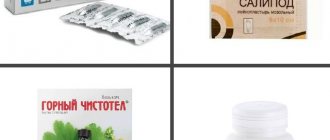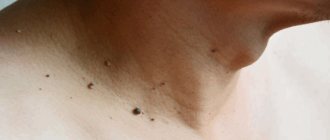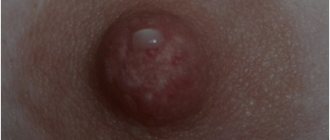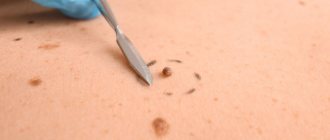Benign skin tumors can have different shapes, structures, colors, sizes, and be localized in different parts of the body. Depending on whether a pimple or mole has formed on the skin, treatment is determined. If atypical neoplasms appear, you should consult a specialist doctor for diagnosis and solution to the issue of removing skin elements. If you try to eliminate the problem yourself, you can injure the skin and provoke negative consequences - growth and malignancy of the tumor.
Seborrheic warts - causes of formation
The causes of seborrheic warts are unknown. But it is reliably clear that they are not related to the HPV papillomavirus, although their name indicates this. Thus, a seborrheic wart has nothing in common with such epidermal lesions as true condylomas, papillomas and warts.
However, there are some factors that predispose you to developing seborrheic warts:
- Age
. Warts most often appear in people over 35 years of age. Many people have more than a dozen of them; - Genetic predisposition
. The presence of seborrheic warts or other epidermal nevi in immediate family members; - Conditions associated with actinic keratosis
or impaired sebum production.
What does a seborrheic wart look like?
Seborrheic papillomas are characteristic mushroom-shaped skin rashes. However, such a wart can be confused with other skin lesions, such as actinic keratosis or some malignancies, mainly cutaneous melanoma. It also happens the other way around, when skin cancer is mistaken for a harmless seborrheic formation.
Keratinized pigmented lesion
Multiple seborrheic keratomas
Development of seborrheic papilloma
Therefore, diagnosis and treatment of any neoplasms should be carried out strictly by an experienced dermatologist. It is strictly prohibited to independently diagnose yourself, much less remove tumors at home.
Here are the features that distinguish a seborrheic wart from other skin lesions:
- Seborrheic papilloma is well demarcated from healthy skin. It gives the impression of being superimposed on the surface.
- The size of the formation ranges from a few millimeters to several centimeters.
- On the surface of the nipple there are numerous depressions containing an accumulated mass of callus epidermal cells and sebum.
- Depending on the stage of development, the color of the nipple varies from a color similar to healthy skin to dark black, which is not a sign of melanoma.
Seborrheic warts are not accompanied by symptoms such as pain, itching, burning. The exception is mechanical irritation, for example, when changing clothes.
Appearance mechanism
You can confuse the inflammatory element (acne, blackhead, pimple) with red-type moles (angiomas, red, pink vascular nevi).
A mole similar to a pimple and pimples in the form of moles appear under the influence of external, internal etiological provocateurs. The formation of inflammation of the skin and vascular elements occurs under the influence of factors:
- Physical, chemical injuries, burns. Hyperproduction of melanocyte cells is provoked, an increase in pigmentation in the lesion, vascular formations are involved, the mole is similar in appearance to acne.
- Infectious lesions of the skin surface in the absence of personal hygiene provoke the development of nodular acne, which is similar in appearance to angiomas.
- Due to hormonal imbalances, age spots and hormonal rashes may appear. The difference is that moles are pointlike and isolated, while inflammatory elements are distributed throughout the body in large numbers. Often a hormonal rash appears on the face, in the nose area.
Pimple
A pimple is an inflammatory element that appears as a result of a malfunction of the sebaceous gland or the addition of a secondary infection (white abscess). The appearance of a growth is dangerous; pus can break into the melanocytes and provoke atypical malignant growth of cellular structures. The basis for the appearance of acne is internal blockage of the sebaceous gland, external contamination of the pores, which disrupts the normal process of renewal of the epidermis by removing subcutaneous fat and desquamation of the epithelium. In case of injury to a mole (tearing off, puncture, scratch, abrasion) or an insect bite (mosquito, bedbug), a pimple may form on top of it, if treatment with antiseptics was not carried out in a timely manner, a bacterial infection was introduced, an irritation reaction to the saliva of the insect occurs, inflammation from damage to the surface layer of the skin or transmission of infection through a bite.
One of the main factors in the appearance is exposure to ultraviolet radiation. Sun rays lead to a decrease in local immunity, disruption of skin metabolism, and increase the risk of inflammatory elements.
Often after sunburn, you can observe white growths - milia, which arise as a result of complete blockage of the sebaceous gland. You can observe excessive formation of acne due to hormonal imbalances in the body during puberty, which is due to hormonal instability and increased sebum production. The ducts do not have time to eliminate subcutaneous fat, the problem of incomplete exfoliation of the epidermis arises, and new inflammatory elements appear.
The basis for disorders of lipid metabolism and general metabolism, which leads to rapid secretion of sebum, is a disrupted diet, addiction to fatty, spicy foods, and lack of sufficient amounts of useful macroelements, vitamins, and minerals.
Moles
Dark pigment spots form on the skin when the production of melanin pigment in melanocyte cells increases. The process of acne appearing on moles depends on factors:
- damage to the skin (sunburn, chemical burn, mechanical damage) can stimulate epithelization, hyperproduction of melanocytes at the wound site;
- hereditary factor in the appearance of formations - provocation of migration, the formation of a large number of melanoblasts at the stage of development of the dermis;
- under the influence of solar insolation or artificial ultraviolet irradiation, there is a change in the production of melanin, which can provoke hyperpigmentation and the appearance of age spots - freckles;
- the appearance of pigment spots can be caused by skin infections, inflammation of the epidermal layer;
- in old age, hyperpigmentation of the skin can occur against the background of thinning of the lipid layer, accumulation of melanocytes, and vascular disorders of the surface capillaries (hemangiomas);
- acne or mole, it can be difficult to determine if there is a red formation - benign vascular tumors that arise when microcirculation processes are disrupted, increased viscosity of the circulatory system, or cardiovascular diseases.
The more active the production, the blacker the formation will be.
Important
Seborrheic warts are benign skin lesions. This means that they cannot turn into cancer cells and be dangerous to health. Seborrheic warts are only an aesthetic problem. Especially when they are on the skin of the face.
The exception is when such a neoplasm is located in a place of constant friction or other traumatic factor. In this case, skin infection may occur. This can result in serious inflammation and even blood poisoning.
Symptoms of demodicosis
Mites destroy the cells of the follicle walls and sebaceous glands. This leads to the appearance of keratinization, foci of inflammation, and pigmentation. Demodex migrates across the skin, exploring new areas; Thus, with increasing demodicosis, the signs of damage spread over an increasingly larger area. It is also assumed that mites cause sensitization of the body, that is, an allergic reaction is added to mechanical damage.
The main symptoms of demodicosis are:
Acne (acne)
Juvenile acne in most cases is a manifestation of demodicosis.
Skin redness
Redness may be accompanied by swelling of the skin.
Itching
Itching with demodicosis usually intensifies at night, when mite activity increases.
More about the symptom
Skin changes
Progressive demodicosis leads to changes in the skin: roughening, peeling, and the appearance of thickenings similar to scars. In the advanced stage, the skin takes on an earthy color.
Blepharitis
When Demodex affects the eyelashes, signs of blepharitis (inflammation of the ciliary edge of the eyelids) develop: the eyelids begin to itch, turn red, swell, and may stick together. The eyes water, inflammation spreads to the conjunctiva - conjunctivitis develops. Loss of eyelashes is observed.
Seborrheic papilloma and cryotherapy
One of the methods for removing seborrheic warts is cryotherapy, that is, freezing the skin lesions with liquid nitrogen. The wart dies off when exposed to very low temperatures.
Cryotherapy
After treatment with liquid nitrogen, literally a few days after the procedure, the color of the wart changes to black, and the skin lesion takes the form of a scab (crust), which disappears from the surface after a month.
Unfortunately, the procedure carries the risk of leaving an unsightly scar, so cryotherapy is not suitable for removing facial warts.
Why a mole can look like a pimple
Moles can look like a pimple for the following reasons:
- due to the similarity of shape and color, small nodular size, the light pink element is difficult to distinguish from a pimple;
- characteristic localization - the sudden appearance of a vascular hemangioma on the face can easily be mistaken for a pimple;
- after hypothermia or overheating in the sun, a primary form of light pink nevus with minimal pigmentation may appear;
- often vascular nevi can disappear on their own or reappear in the same place under the influence of unfavorable internal or external factors;
- one of the reasons for the appearance of a red nevus is a disruption of the digestive tract; the appearance of a new element is provoked after eating junk food, which a person often mistakes for an allergic rash.
Do not rush to remove the growth immediately, wait to make sure the diagnosis is accurate.
Seborrheic wart and IPL laser
Another method for removing seborrheic warts is the use of an IPL laser, which completely burns away the skin lesions, leaving a small concave socket.
IPL laser treatment
Within a few days after the procedure, a scab will form, which will fall off after 2-3 weeks. After treatment, a scar may also remain, but, unlike the previous option, it is almost invisible. Therefore, warts on the face are removed with a laser. A similar effect is also achieved by the radio knife, another modern tool designed to remove moles and warts of almost any type.
Seborrheic wart - surgical treatment
Removal of skin lesions with a surgical scalpel involves removal of the wart at the epidermal level. This method is suitable for large lesions on the body.
Surgery
It is important to understand that the choice of method for removing seborrheic papilloma should be made by a dermatologist. Some tumors may raise doubts about their origin, so it is important to preserve the removed tissue for analysis. In this case, the doctor will choose a surgical method, since the laser and liquid nitrogen completely remove the affected tissue, so there will be nothing to take for analysis.
ONLINE REGISTRATION at the DIANA clinic
You can sign up by calling the toll-free phone number 8-800-707-15-60 or filling out the contact form. In this case, we will contact you ourselves.
Methods for diagnosing such a mole
To accurately determine whether a mole similar to a pimple has emerged or an inflammatory skin element has appeared, you need to consult a specialist doctor who will conduct a thorough examination and prescribe research methods to accurately determine the origin of the neoplasm.
If there are no problematic issues, the doctor may limit himself to examination using a dermatoscope (an optical apparatus with a magnifying glass and a fluorescent lamp to illuminate the surface of the skin); no tests will be needed. To accurately determine the nature of the pigment formation, the doctor can take a biopsy for histological analysis and determine the tissue composition of the formation.
Independent attempts to determine whether a mole or acne may be inaccurate; if you try to remove the formation, negative consequences may occur; it is worth seeking qualified medical help.











